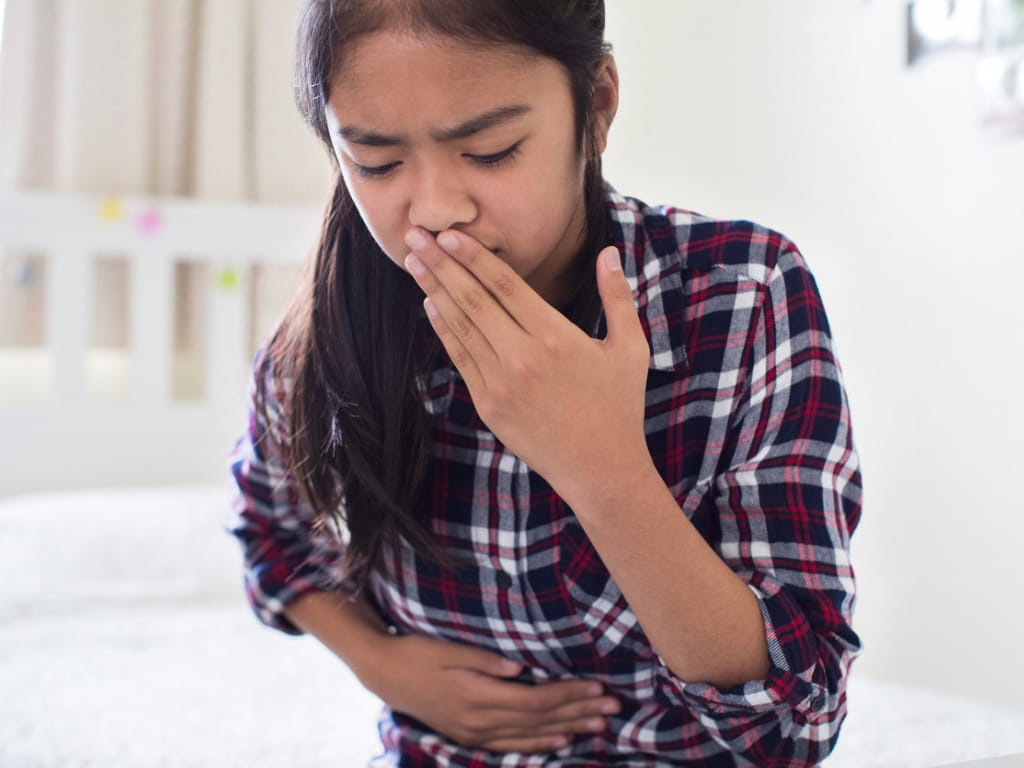What is Norovirus?

The Bottom Line
Norovirus is a contagious illness that causes vomiting and diarrhea in both adults and children. Norovirus can be transmitted through contact with an infected person’s vomit or feces, and can also spread through contaminated foods. Hand washing with soap and water can help prevent the spread of norovirus, and infection is typically self-limited.

What is norovirus?
Norovirus (formerly known as Norwalk-like virus) is a highly contagious virus that is a common cause of gastroenteritis (“stomach bug” or “stomach flu”). The first norovirus infection was discovered in 1972 after an outbreak of gastroenteritis affected an elementary school in Norwalk, Ohio. Since then, multiple different types of noroviruses have been identified that are known to cause gastrointestinal illness in individuals of all ages. Each year, noroviruses are responsible for approximately 20 million illnesses, 460,000 Emergency Department visits, and 900 deaths in the United States.
Is norovirus food poisoning?
Noroviruses can cause food poisoning. Norovirus can be spread through foods that are prepared, handled, or served by infected individuals. Shellfish that are harvested from waters contaminated with norovirus can also carry the disease, which can then infect individuals who consume the shellfish. Fresh fruits and vegetables can become contaminated with norovirus due to irrigation with contaminated water. Norovirus has been detected in both fresh and frozen berries, as well as in pomegranate arils.
How does norovirus spread?
Norovirus is very contagious, and exposure to as few as 18 norovirus particles is enough to cause infection (as opposed to the thousands of viral particles that are needed to cause influenza infection). Norovirus can spread when viral particles from an infected individual’s vomit or feces are transferred to another person. Infected viral particles can be spread through direct person-to-person contact or indirectly through contact with contaminated surfaces, which can harbor the virus for as long as 50 days. Norovirus can be transmitted through food or water contaminated with germs from an infected person. In addition, aerosolized viral particles can spread through the air after an infected individual vomits or has a bowel movement. While many people infected with norovirus have gastrointestinal signs or symptoms, some may be asymptomatic and can spread the virus even if they don’t feel sick at all.
When is norovirus contagious?
People infected with norovirus are contagious both when they are symptomatic and for the first few days after symptoms have resolved. However, in some individuals, the virus can still be found in feces for more than 2 months after infection.
Is norovirus airborne?
Norovirus is most commonly spread by direct contact with contaminated feces or vomit. However, airborne transmission of viral particles has been reported. More than 30 million norovirus particles can be spread throughout the air during an episode of vomiting. People who are in close proximity to a vomiting individual may unintentionally swallow or breathe in aerosolized viral particles and contract infection.
What are norovirus symptoms?
Common symptoms of norovirus infection include nausea, vomiting, diarrhea, stomach aches, and headache. Norovirus can also cause fever and body aches. Symptoms usually begin within two days of exposure to an infected individual, and can last for several days. While most people recover from norovirus infection without complications, young children and older adults may develop severe infections that can require hospitalization.
What is the treatment for norovirus?
There is no cure for norovirus, and treatment is based on individual signs and symptoms. Since vomiting and diarrhea can cause dehydration, it’s important for infected individuals to consume plenty of fluids. Young children and older adults are at higher risk for dehydration or other complications from norovirus infection, and should be monitored closely until symptoms resolve. Antibiotics are not effective in treating norovirus, and there are currently no vaccines or antiviral drugs that are proven effective for the prevention or treatment of norovirus.
What kills norovirus?
Bleach-based disinfectants can kill norovirus. The United States Environmental Protection Agency (EPA) maintains a list of products that are effective at killing norovirus. Noroviruses can survive extremes of temperatures and can thrive in both hot and cold environments. Alcohol-based hand sanitizers and chlorine do not reliably kill norovirus, but simple hand washing with soap and water can be effective in reducing norovirus transmission between people.
What do you do if you think you have norovirus?
If food poisoning symptoms develop, get guidance from Poison Control immediately. Help from Poison Control is available at www.poison.org and by phone at 1-800-222-1222. Both options are free, confidential, and available 24 hours a day.
Kelly Johnson-Arbor, MD
Medical Toxicologist
For media inquiries, please contact Krista Osterthaler at osterthaler@poison.org.
Poisoned?
Call 1-800-222-1222 or
Prevention Tips
- Always wash your hands with soap and water before preparing, handling, or serving food.
- Cook shellfish to an internal temperature of 145 degrees Fahrenheit (norovirus can survive temperatures up to 140 degrees Fahrenheit).
- If you have norovirus symptoms, do not cook, handle, or serve food or provide hands-on care to others for at least two days after your symptoms completely resolve.
This Really Happened
Within two days of attending a wedding reception at a Nebraska event hall, thirty individuals developed vomiting, diarrhea, abdominal pain, and fever. Over the next few weeks, multiple other cases involving similar gastrointestinal symptoms were reported in individuals who attended events at the same facility. The local health department conducted an investigation and detected norovirus in the feces of several of the infected individuals. The investigators learned that an individual who attended the wedding reception had vomited on the carpet in the facility’s lobby at the start of the event. The carpet had been cleaned and vacuumed, but had not been disinfected with a product registered by the EPA to kill norovirus. The health department investigators determined that the combination of inadequate disinfection and aerosolization of viral particles from vacuum cleaning likely contributed to further spread of norovirus throughout the event facility.For More Information
References
Poisoned?
Call 1-800-222-1222 or
Prevention Tips
- Always wash your hands with soap and water before preparing, handling, or serving food.
- Cook shellfish to an internal temperature of 145 degrees Fahrenheit (norovirus can survive temperatures up to 140 degrees Fahrenheit).
- If you have norovirus symptoms, do not cook, handle, or serve food or provide hands-on care to others for at least two days after your symptoms completely resolve.
